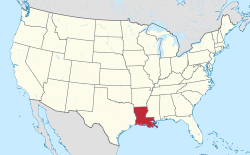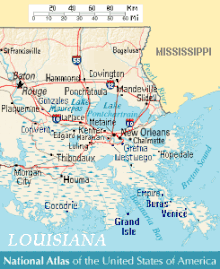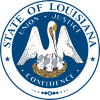Bogalusa, Louisiana
Bogalusa, Louisiana | |
|---|---|
City | |
 Great Southern Lumber Company in Bogalusa, 1930s | |
 Location of Bogalusa in Washington Parish, Louisiana. | |
 Location of Louisiana in the United States | |
| Coordinates: 30°46′50″N 89°51′50″W / 30.78056°N 89.86389°W / 30.78056; -89.86389Coordinates: 30°46′50″N 89°51′50″W / 30.78056°N 89.86389°W / 30.78056; -89.86389 | |
| Country | United States |
| State | Louisiana |
| Parish | Washington |
| Incorporated | July 4, 1914 |
| Government | |
| • Mayor | Wendy O'Quin Perrette[1] (No Party) |
| Area [2] | |
| • Total | 35.00 sq mi (90.64 km2) |
| • Land | 33.10 sq mi (85.74 km2) |
| • Water | 1.89 sq mi (4.90 km2) |
| Elevation | 95 ft (29 m) |
| Population (2010) | |
| • Total | 12,232 |
| • Estimate (2016)[3] | 11,913 |
| • Density | 359.87/sq mi (138.95/km2) |
| Time zone | UTC-6 (CST) |
| • Summer (DST) | UTC-5 (CDT) |
| Area code(s) | 985 |
| FIPS code | 22-08150 |
| Website | http://www.bogalusa.org |
Bogalusa is a city in Washington Parish, Louisiana, United States. The population was 12,232 at the 2010 census. It is the principal city of the Bogalusa Micropolitan Statistical Area, which includes all of Washington Parish and is also part of the larger New Orleans–Metairie–Bogalusa Combined Statistical Area.
The name of the city derives from the Choctaw language term bogue lusa, which translates to "dark water" in English.[4] Located in an area of pine forests, in the early 20th century, this industrial city was developed as a company town, to provide worker housing and services in association with a Great Southern Lumber Company sawmill. In the late 1930s, this operation was replaced with paper mills and chemical operations.
Contents
1 History
1.1 The timber industry
1.2 Racial conflict
1.3 Since 1970
2 Commemoration
3 Geography
4 Demographics
5 Economy
6 Government
7 Education
8 Notable people
9 References
10 Further reading
11 External links
History

1911 Bogalusa maps
The timber industry
In the early 1900s, brothers Frank Henry Goodyear and Charles W. Goodyear of Buffalo, New York, bought hundreds of thousands of acres of virgin pine forests in southeastern Louisiana and southwestern Mississippi. They had already been successful in lumbering isolated areas in New York and Pennsylvania, and had developed a strategy of building railroad spurs to provide access to the forests. In 1902, they chartered the Great Southern Lumber Company (1908–38) and built its sawmill in what became Bogalusa, a company town which they built to support this rural operation. The sawmill was the largest in the world at the time.[5] The Goodyear interests built the city of Bogalusa to house workers and supervisors, and associated infrastructure. They also built the Great Northern New Orleans Railroad to New Orleans to transport their lumber and products to market.
The city, designed by architect Rathbone DeBuys of New Orleans and built from the ground up in less than a year, had several hotels, a YMCA and YWCA, churches of all faiths, and houses for the workers and supervisors. It was called the "Magic City" due to its rapid construction. The manager of Great Southern Lumber Company was William H. Sullivan. As sawmill manager, he acted as town boss when the city was built. After Bogalusa was incorporated as a city on July 4, 1914, Sullivan was elected as mayor by white voters (blacks had been disenfranchised), and repeatedly re-elected, serving until his death on June 26, 1929.

Bogalusa (top) in regional map, northeast of Baton Rouge and Hammond, north of New Orleans
The Great Southern Lumber Company's sprawling sawmill produced up to 1,000,000 board feet (2400 m3) of lumber each day. With the virgin pine forest cleared, the sawmill closed in 1938 during the Great Depression. It was replaced as the city's main industry by a paper mill and a chemical plant run by Gaylord Container Corporation.
Crown-Zellerbach acquired Gaylord's operations in 1955. An attempt to keep the sawmill open with California redwood proved too costly, and the mill was closed. A paper mill and chemical operations continued. At its peak in 1960, the city had more than 21,000 residents.
Racial conflict
The Bloody Bogalusa Massacre occurred in 1919 when black workers at the saw mill attempted to organize a labor union, and were gunned down by the largest private army in Louisiana. At the time, the mill was surrounded by barbed wire and fitted with machine guns. Black men were arrested nightly for minor offenses and brought at gunpoint to be forced labor at the mill by local law enforcement. If any were too sick or refused to work, they were beaten.[6]
Both black and white industrial workers had come to the company town for work. After World War II and service for their country, African-American veterans struggled in Louisiana and the South against the oppression of Jim Crow laws, state segregation, and disenfranchisement and exclusion from the political system, all continuing since the turn of the 20th century.
During the civil rights era, black workers pressed Crown Zellerbach to open all positions to them, promote them to supervisory positions, and otherwise give them equal opportunities at work. White workers resisted these changes. Blacks pressured the city to integrate public facilities, especially after passage of national civil rights legislation.
In Bogalusa, black workers also struggled against the industrial class system. As their activism increased in the civil rights era, whites resisted. Local Ku Klux Klan members dominated the region, attacking and intimidating civil rights activists in the 1960s. In 1964, as civil rights activists continued to push for their constitutional rights after congressional passage that year of the Civil Rights Act that year, whites increased their attacks.
Determined to fight for their rights, Robert "Bob" Hicks, Charles Sims, A.Z. Young, and others had taken leadership of the (all-black) Bogalusa Civic and Voters’ League. On February 21, 1965, with the help of three activists from the Deacons for Defense and Justice based in Jonesboro, Louisiana, they founded the first affiliated chapter of the African-American self-defense organization. Other leaders of the Deacons were Bert Wyre, Aurilus “Reeves” Perkins, Sam Bonds, Fletcher Anderson and others.[7] They mobilized many veterans of the black community to provide armed security to civil rights activists and their families.[8][9] Expecting a violent summer, the State Police established an office in Bogalusa in February.[8]
As explained by Seth Hague,
...the community came to embrace the militant rhetoric of the Jonesboro Deacons. Many violent conflicts ensued under this ideology and culminated in a climactic summer in 1965. Consequently, the black workers’ militancy threatened not only the power of the middle class blacks, but also the political and economic hegemony of the white power structure in Bogalusa. Except for a few noteworthy courtroom "victories" versus Crown-Zellerbach, threatening the power structure was virtually the struggle's only effect as the white power structure subsumed the militancy and rhetoric of the revolutionary Bogalusans."[8]
Two unsolved murders of African Americans took place in Bogalusa during the civil rights era: in 1965 Oneal Moore, the first black deputy sheriff for the Washington Parish Sheriff's Office, and in 1966 Clarence Triggs.
Since 1970
With changes in the lumber industry, through the late 20th century, after 1960, a steady decline in industrial operations, jobs, and associated population of the town occurred. By 2015, the population was estimated at slightly less than 12,000,[10] more than 40% below the high in 1960. These conditions have made it more difficult for remaining residents.
In 1995, a railroad tank car imploded at Gaylord Chemical Corporation, releasing nitrogen tetroxide and forcing the evacuation of about 3,000 people within a one-mile (1.6 km) radius. Residents say "the sky turned orange" as a result. Emergency rooms filled with about 4,000 people who complained of burning eyes, skin, and lungs. Dozens of lawsuits were filed against Gaylord Chemical and were finally settled in May 2005, with compensation checks issued to around 20,000 people affected by the accident.
On August 29, 2005, Hurricane Katrina hit the city with winds of about 110 mph (175 km/h), downing numerous trees and power lines. Many buildings in Bogalusa were damaged from falling trees, and several were destroyed. Most of the houses, businesses, and other buildings suffered roof damage from the storm's ferocious winds. Some outlying areas of the city were without power for more than a month.
Commemoration
- The Robert "Bob" Hicks House was listed on the National Register of Historic Places in 2015.
- The Robert Hicks Foundation was established to carry on the work for civil rights. An annual award is made in his name.[7]
Deacons for Defense is a 2003 television movie made about the 1965 civil rights struggle in Bogalusa. Directed by Bill Duke, it stars Academy Award-winner Forest Whitaker, with Ossie Davis and Jonathan Silverman.- A Bogalusa Civil Rights Museum is planned to open in the city in 2018, to commemorate the struggle in the 1960s and continuing work for social justice.
Geography
Bogalusa has an elevation of 100 feet (30.5 m).[11]
According to the United States Census Bureau, the city has a total area of 9.5 square miles (24.6 km2), of which 9.5 square miles (24.6 km2) is land and 0.1 square miles (0.3 km2) (0.52%) is covered by water.
Demographics
| Historical population | |||
|---|---|---|---|
| Census | Pop. | %± | |
| 1920 | 8,245 | — | |
| 1930 | 14,029 | 70.2% | |
| 1940 | 14,604 | 4.1% | |
| 1950 | 17,798 | 21.9% | |
| 1960 | 21,423 | 20.4% | |
| 1970 | 18,412 | −14.1% | |
| 1980 | 16,976 | −7.8% | |
| 1990 | 14,280 | −15.9% | |
| 2000 | 13,365 | −6.4% | |
| 2010 | 12,232 | −8.5% | |
| Est. 2016 | 11,913 | [3] | −2.6% |
| U.S. Decennial Census[12] | |||
As of the census[13] of 2000, 13,365 people, 5,431 households, and 3,497 families resided in the city. The population density was 1,407.6 people per square mile (543.8/km²). The 6,300 housing units averaged 663.5 per square mile (256.3/km²). The racial makeup of the city was 57.18% White, 41.21% African American, 0.32% Native American, 0.39% Asian, 0.16% from other races, and 0.73% from two or more races. Hispanics or Latinos of any race were 0.75% of the population.
Of the 5,431 households, 29.3% had children under the age of 18 living with them, 36.1% were married couples living together, 23.8% had a female householder with no husband present, and 35.6% were not families. About 32.7% of all households were made up of individuals, and 16.5% had someone living alone who was 65 years of age or older. The average household size was 2.41 and the average family size was 3.05.
In the city, the population was distributed as 27.4% under the age of 18, 9.2% from 18 to 24, 23.9% from 25 to 44, 21.3% from 45 to 64, and 18.2% who were 65 years of age or older. The median age was 37 years. For every 100 females, there were 82.7 males. For every 100 females age 18 and over, there were 76.0 males.
The median income for a household in the city was $19,261, and for a family was $24,947. Males had a median income of $26,716 versus $17,992 for females. The per capita income for the city was $11,476. About 26.1% of families and 32.9% of the population were below the poverty line, including 45.1% of those under age 18 and 22.0% of those age 65 or over.
Economy
Bogalusa was founded by the Goodyears of Buffalo, New York, who chartered the Great Southern Lumber Company in 1902.[5] The sawmill was, for many years, the largest in the world. The company was famous for its reforestation program.

Ad in Southern Engineer, Volume 27, 1917, promoting Bogalusa
In 1938, the Goodyear family's mill had clear cut all the virgin longleaf yellow pine within hundreds of miles of Bogalusa and, after an unprofitable effort to import redwood from California ended their sawmill operations at the Great Southern Lumber Company; the next phase was run by Gaylord. This was bought by Crown Zellerbach, which in turn was acquired by Georgia Pacific in 1986. Its brown paper successor Gaylord Container Corporation owned it until 2002, when Gaylord was acquired by Temple-Inland Corporation, the area's largest employer. As of 2012, the paper mill was owned by International Paper, which acquired Temple-Inland.
Bogalusa's economy revolves around the lumber and paper mills, as well as agriculture.
Government
Bogalusa is home to the 205th Engineer Battalion of the Louisiana Army National Guard. This unit is part of the 225th Engineer Brigade, which is headquartered in Pineville, Louisiana, at Camp Beauregard.
Education
Bogalusa operates its own public school system, Bogalusa City Schools.
Northshore Technical Community College is located in Bogalusa. In 1930, it was the first trade school established in the state of Louisiana, and it is now a fully accredited community college.
Notable people
Kenderick Allen, NFL defensive lineman 2003-08
Ernest Angelo, Texas oilman and Republican politician, reared partly in Bogalusa
Perry Brooks (1954–2010), football defensive tackle, Washington Redskins (1977–1984), Super Bowl XVII champion
Jacob Brumfield (born in 1965 in Bogalusa), professional baseball outfielder from 1992-1999
Al Clark, NFL player 1971-76
Tom Colten, secretary of Louisiana Department of Transportation and Development; business manager of thrice-weekly Bogalusa Daily News from 1948 until his relocation in 1955 to Minden in Webster Parish, where he served two terms as mayor
James Crutchfield (1912–2001), barrelhouse blues piano player; raised in Bogalusa
Robert "Bob" Hicks, civil rights sctivist. See above.
Trumaine Johnson, Grambling and professional football player; born in Bogalusa
Theodore "Ted" Jones, lawyer, lobbyist, political appointee from Baton Rouge; maintains voter registration in Bogalusa
Yusef Komunyakaa (born in 1947 in Bogalusa), winner of 1994 Pulitzer Prize for Poetry; born James Willie Brown, Jr.
Skip Manning (1934-), 1976 NASCAR Winston Cup Rookie of the Year
John McGeever, NFL cornerback 1962-66
Beth Mizell (born in 1952 in Bogalusa), state senator for Washington Parish
Ben Nevers, state senator from Washington, St. Helena, St. Tammany, and Tangipahoa Parishes, 2004-2016
Henry "Tank" Powell, represented Tangipahoa Parish in state legislature 1996-2008; member of Louisiana Board of Pardons
Professor Longhair (1918-1980), funky pianist who inspired artists such as Dr. John; several of his songs are Mardi Gras anthems
Snoozer Quinn (1907–1949), pioneer of jazz guitar; raised in Bogalusa
Jared Y. Sanders, Sr., former governor, arranged tax breaks for GSL and helped the sawmill with startup
Jared Y. Sanders, Jr., former U.S. representative and state legislator, practiced law in Bogalusa early in 20th Century
Charlie Spikes, the "Bogalusa Bomber"; MLB player 1972-1980, New York Yankees, Cleveland Indians, Detroit Tigers, Atlanta Braves
Jerry Thomas, physician in Franklinton, represented Washington Parish in both houses of state legislature, 1992-2004
Tom Thornhill, Slidell attorney and member of Louisiana House of Representatives from 1996–2000; raised in Bogalusa and graduated from Bogalusa High School
Clarence Triggs, unsolved murder
Malinda Brumfield White (born 1967), member of Louisiana House of Representatives from Bogalusa
Dub Williams, New Mexico legislator
References
^ City of Bogalusa: Mayor's Office Archived 2016-09-13 at the Wayback Machine Retrieved 2015-06-03
^ "2016 U.S. Gazetteer Files". United States Census Bureau. Retrieved Jul 12, 2017..mw-parser-output cite.citation{font-style:inherit}.mw-parser-output .citation q{quotes:"""""""'""'"}.mw-parser-output .citation .cs1-lock-free a{background:url("//upload.wikimedia.org/wikipedia/commons/thumb/6/65/Lock-green.svg/9px-Lock-green.svg.png")no-repeat;background-position:right .1em center}.mw-parser-output .citation .cs1-lock-limited a,.mw-parser-output .citation .cs1-lock-registration a{background:url("//upload.wikimedia.org/wikipedia/commons/thumb/d/d6/Lock-gray-alt-2.svg/9px-Lock-gray-alt-2.svg.png")no-repeat;background-position:right .1em center}.mw-parser-output .citation .cs1-lock-subscription a{background:url("//upload.wikimedia.org/wikipedia/commons/thumb/a/aa/Lock-red-alt-2.svg/9px-Lock-red-alt-2.svg.png")no-repeat;background-position:right .1em center}.mw-parser-output .cs1-subscription,.mw-parser-output .cs1-registration{color:#555}.mw-parser-output .cs1-subscription span,.mw-parser-output .cs1-registration span{border-bottom:1px dotted;cursor:help}.mw-parser-output .cs1-ws-icon a{background:url("//upload.wikimedia.org/wikipedia/commons/thumb/4/4c/Wikisource-logo.svg/12px-Wikisource-logo.svg.png")no-repeat;background-position:right .1em center}.mw-parser-output code.cs1-code{color:inherit;background:inherit;border:inherit;padding:inherit}.mw-parser-output .cs1-hidden-error{display:none;font-size:100%}.mw-parser-output .cs1-visible-error{font-size:100%}.mw-parser-output .cs1-maint{display:none;color:#33aa33;margin-left:0.3em}.mw-parser-output .cs1-subscription,.mw-parser-output .cs1-registration,.mw-parser-output .cs1-format{font-size:95%}.mw-parser-output .cs1-kern-left,.mw-parser-output .cs1-kern-wl-left{padding-left:0.2em}.mw-parser-output .cs1-kern-right,.mw-parser-output .cs1-kern-wl-right{padding-right:0.2em}
^ ab "Population and Housing Unit Estimates". Retrieved June 9, 2017.
^ Leeper, Clare D'Artois (19 October 2012). Louisiana Place Names: Popular, Unusual, and Forgotten Stories of Towns, Cities, Plantations, Bayous, and Even Some Cemeteries. LSU Press. p. 42. ISBN 978-0-8071-4740-5.
^ ab LSU Libraries—Great Southern Lumber Company Collection Archived 2014-07-15 at the Wayback Machine Retrieved 2013-12-28
^ http://www.internationalist.org/bloodybogalusa19191202.html
^ ab "Deacons for Defense and Justice", Robert Hicks Foundation website
^ abc Seth Hague, " 'Niggers Ain’t Gonna Run This Town': Militancy, Conflict and the Sustenance of the Hegemony in Bogalusa, Louisiana", Outstanding History Paper (1997-1998), Loyola University-New Orleans; accessed 11 May 2017
^ "» The Deacons". Gimlet Media. Retrieved 2016-11-24.
^ "Annual Estimates of the Resident Population for Incorporated Places: April 1, 2010 to July 1, 2015". Archived from the original on 2016-06-02. Retrieved July 2, 2016.
^ "US Board on Geographic Names". United States Geological Survey. 2007-10-25. Retrieved 2008-01-31.
^ "Census of Population and Housing". Census.gov. Archived from the original on May 12, 2015. Retrieved June 4, 2015.
^ "American FactFinder". United States Census Bureau. Archived from the original on 2013-09-11. Retrieved 2008-01-31.
Further reading
Honigsberg, Peter Jan (2000). Crossing Border Street: A Civil Rights Memoir. University of California Press. ISBN 0520221478.
Keller, Larry (Summer 2009). "Klan Murder Shines Light on Bogalusa, LA". Intelligence Report.
External links
Courtenay De Kalb, "Perpetual Timber Supply Through Reforestation as Basis For Industrial Permanency: The Story Of Bogalusa", July 1921
Bogalusa Story by C. W. Goodyear, posted at freepages/Rootsweb- Bogalusa, Washington Parish, Louisiana: history, links, maps, and photos
- City of Bogalusa
- Bogalusa Chamber of Commerce
- Bogalusa Daily News
| Wikimedia Commons has media related to Bogalusa, Louisiana. |
- Bogalusa City Schools
International Paper, Inc., official website- Photos of Hurricane Katrina Damage, 2005

